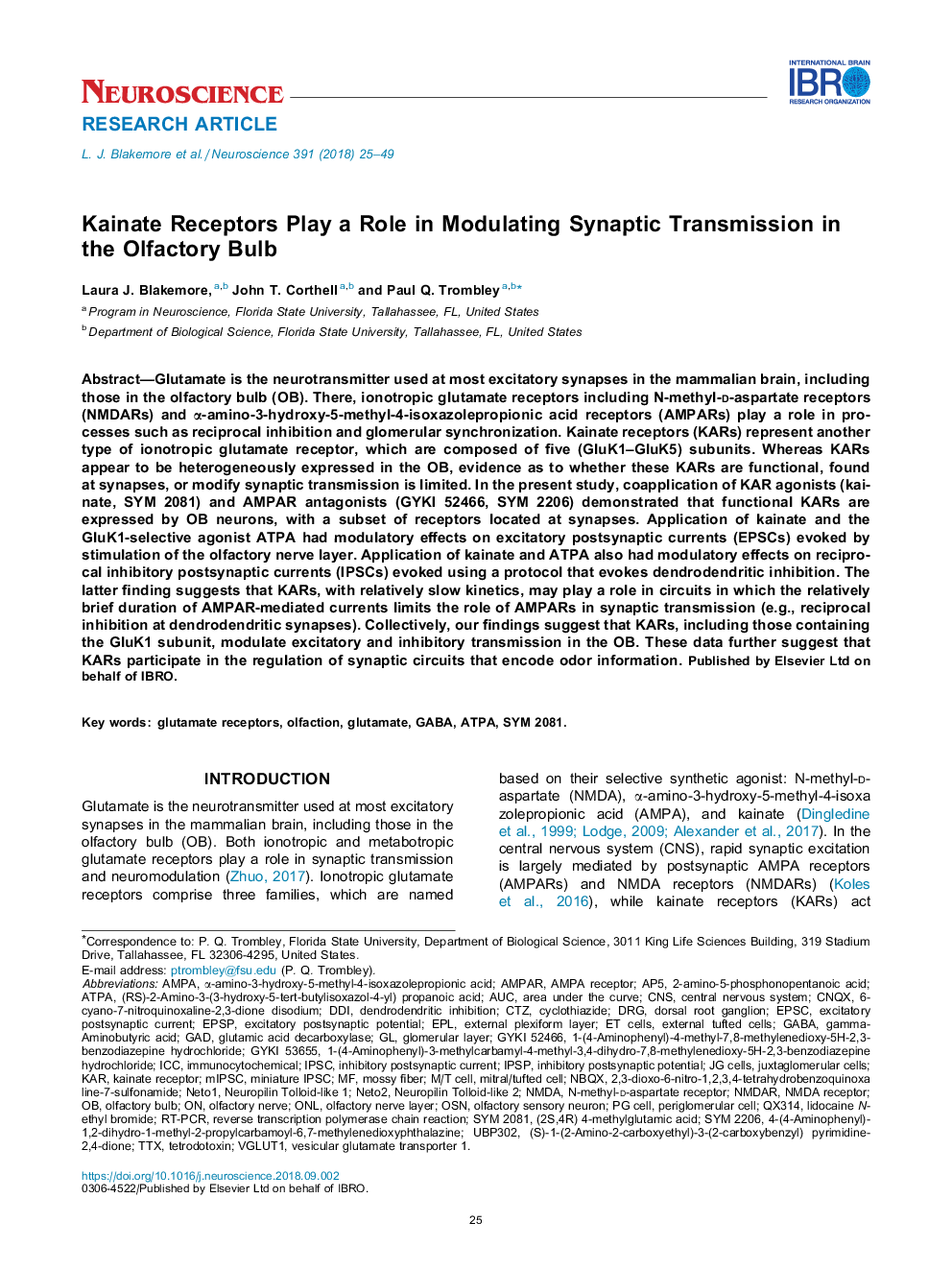| کد مقاله | کد نشریه | سال انتشار | مقاله انگلیسی | نسخه تمام متن |
|---|---|---|---|---|
| 10223138 | 1701010 | 2018 | 25 صفحه PDF | دانلود رایگان |
عنوان انگلیسی مقاله ISI
Kainate Receptors Play a Role in Modulating Synaptic Transmission in the Olfactory Bulb
ترجمه فارسی عنوان
گیرنده های کینات نقش مهمی در انتقال سیناپتیک در لامپ رژیم غذایی دارند
دانلود مقاله + سفارش ترجمه
دانلود مقاله ISI انگلیسی
رایگان برای ایرانیان
کلمات کلیدی
GYKI 52466TTXNMDADendrodendritic inhibitionminiature IPSCAP5EPLIPSCNMDARGYKI 53655ONLVGLUT1NBQXIPSPmIPSCATPACTZICCQX314RT-PCRDRGDDIAMPARAMPAGAD6-cyano-7-nitroquinoxaline-2,3-dione disodiumdorsal root ganglion - گانگلیون ریشه پشتی2-amino-5-phosphonopentanoic acid - 2-آمینو-5-فسفونوپنتانوئیک اسیدAUC - AUCEPSC - EPSCoREPSP - epspiglutamic acid decarboxylase - glutamic acid dearboxylaseNMDA receptor - NMDA گیرندهα-amino-3-hydroxy-5-methyl-4-isoxazolepropionic acid - اسید α-آمینو 3-هیدروکسی-5-متیل-4-ایزوکسول پپونیکgamma-aminobutyric acid - اسید گاما آمینو بوتیریکImmunocytochemical - ایمونوسیتوشیمیاییolfaction - بویاییtetrodotoxin - تترو دوتوکسین inhibitory postsynaptic current - جریان پستانیپتیک مهارکنندهexcitatory postsynaptic current - جریان پستیینپتیک تحریک کنندهvesicular glutamate transporter 1 - حمل کننده گلوتامات وزیکولار 1CNS - دستگاه عصبی مرکزیOSN - سازمان ملل متحدPeriglomerular cell - سلول PeriglomerularJuxtaglomerular cells - سلولهای یوکساتگلومرالCNQX - سیانکیوایکسcentral nervous system - سیستم عصبی مرکزیcyclothiazide - سیکلوتیازیدOlfactory nerve - عصب التهابیolfactory sensory neuron - عصب حساس بویاییmossy fiber - فیبر قارچexternal plexiform layer - لایه بیرونی خارجیolfactory nerve layer - لایه عصبی بویاییglomerular layer - لنف گلومرولیarea under the curve - منطقه تحت منحنیmitral/tufted cell - میترال / سلول خونیreverse transcription polymerase chain reaction - واکنش زنجیره ای پلیمراز رونویسی معکوسexcitatory postsynaptic potential - پتانسیل پست سیناپتی هیجان انگیزinhibitory postsynaptic potential - پتانسیل پستانیپتیک مهارکنندهolfactory bulb - پیاز بویاییKar - کارGABA - گاباglutamate - گلوتاماتAMPA receptor - گیرنده AMPAN-methyl-d-aspartate receptor - گیرنده N-methyl-d-aspartateGlutamate receptors - گیرنده های گلوتاماتKainate receptor - گیرنده کینات
موضوعات مرتبط
علوم زیستی و بیوفناوری
علم عصب شناسی
علوم اعصاب (عمومی)
چکیده انگلیسی
Glutamate is the neurotransmitter used at most excitatory synapses in the mammalian brain, including those in the olfactory bulb (OB). There, ionotropic glutamate receptors including N-methyl-d-aspartate receptors (NMDARs) and α-amino-3-hydroxy-5-methyl-4-isoxazolepropionic acid receptors (AMPARs) play a role in processes such as reciprocal inhibition and glomerular synchronization. Kainate receptors (KARs) represent another type of ionotropic glutamate receptor, which are composed of five (GluK1-GluK5) subunits. Whereas KARs appear to be heterogeneously expressed in the OB, evidence as to whether these KARs are functional, found at synapses, or modify synaptic transmission is limited. In the present study, coapplication of KAR agonists (kainate, SYM 2081) and AMPAR antagonists (GYKI 52466, SYM 2206) demonstrated that functional KARs are expressed by OB neurons, with a subset of receptors located at synapses. Application of kainate and the GluK1-selective agonist ATPA had modulatory effects on excitatory postsynaptic currents (EPSCs) evoked by stimulation of the olfactory nerve layer. Application of kainate and ATPA also had modulatory effects on reciprocal inhibitory postsynaptic currents (IPSCs) evoked using a protocol that evokes dendrodendritic inhibition. The latter finding suggests that KARs, with relatively slow kinetics, may play a role in circuits in which the relatively brief duration of AMPAR-mediated currents limits the role of AMPARs in synaptic transmission (e.g., reciprocal inhibition at dendrodendritic synapses). Collectively, our findings suggest that KARs, including those containing the GluK1 subunit, modulate excitatory and inhibitory transmission in the OB. These data further suggest that KARs participate in the regulation of synaptic circuits that encode odor information.
ناشر
Database: Elsevier - ScienceDirect (ساینس دایرکت)
Journal: Neuroscience - Volume 391, 1 November 2018, Pages 25-49
Journal: Neuroscience - Volume 391, 1 November 2018, Pages 25-49
نویسندگان
Laura J. Blakemore, John T. Corthell, Paul Q. Trombley,
